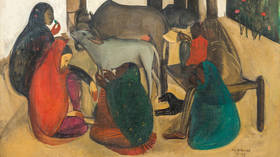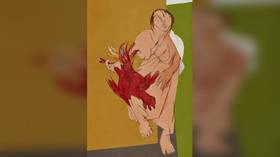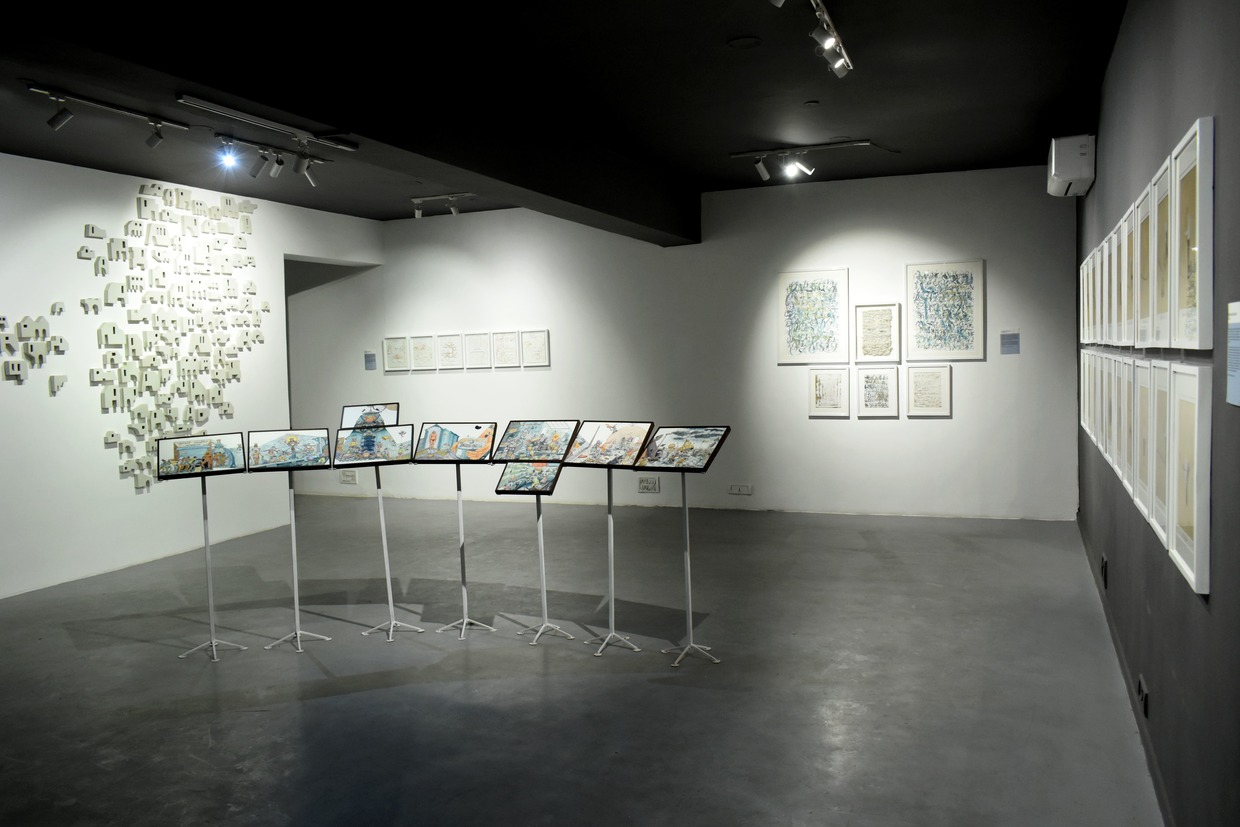The Indian art market is booming: Will New Delhi become a global auction capital?


The Indian art market is soaring and it feels apt that work by Amrita Sher-Gil – the undisputed queen of modern Indian art – is leading the charge. Her 1937 masterpiece ‘The Story Teller’ recently became the most expensive Indian painting ever sold at auction.
During Saffronart’s high-profile Evening Sale on September 16, ‘The Story Teller’ fetched a staggering 618 million rupees ($7.4 million), a price nearly twice its upper estimate, according to Saffronart co-founder Minal Vazirani.
Long recognized as a national treasure by the government, Sher-Gil (1913-1941) consistently stood out among India’s overwhelmingly male-dominated art scene. The record sale of ‘The Story Teller’ “marks a significant milestone in the South Asian art ecosystem, as it is not only the highest value work but is a record held by a woman – certainly a marker to be celebrated in India,” Vazirani tells RT.
Back in 2021, Sher-Gil’s painting ‘Ladies’ Enclosure’ went under the hammer for 378 million rupees ($5.14 million) at Saffronart’s Summer Live auction, making it the second-most expensive work of Indian art sold globally at the time. Incredibly, the market value of her artworks has almost doubled within a span of just two years.
However, Sher-Gil is hardly the only Indian artist whose paintings have become brand names or status symbols worth millions of rupees. Barely a week before the sale of ‘The Story Teller’, the late Sayed Haider Raza’s abstract reverie, ‘Gestation’ (1989), made headlines when it fetched 517.5 million rupees ($6.27 million) at Pundole’s, a Mumbai-based auction house.
Raza was a founding member of the iconic Progressive Artists’ Group formed in 1947 in post-independent Bombay. His contemporaries included M.F. Husain, V.S. Gaitonde, F.N. Souza, Tyeb Mehta, Ram Kumar, and Krishen Khanna – all of whom would go on to become key figures in Indian modern art. In the current market, their works command astronomical prices.
In 2021, a towering abstract canvas by Gaitonde was snapped up for almost 340 million rupees ($5.5 million) at the Saffronart Spring Live auction. A year later, in February 2022, that record was surpassed when a monumental Gaitonde work racked up an eye-popping 420 million rupees ($5.9 million) at a Pundole auction in Mumbai.

If India is currently ranked among the fastest growing economies in the world, then the country’s art industry is a fascinating case study with tremendous growth potential and latent firepower of its own. Despite the Covid-19 pandemic’s devastating impact on businesses, the modern and contemporary art market has gradually bounced back and is now conquering new heights. According to data from Grant Thorton’s Indian Art Market Report, the market had reached a record turnover of 10.25 billion rupees ($137 million) as of 2022, a startling 281% increase since 2012.
“The Indian art market has witnessed a significant growth over the last five years, with 2022 surging to establish a new peak in the art market (public auctions exceeded the previous peak of 2008 which was $143 million),” says Vazirani.
Mumbai-based auction house AstaGuru also has huge expectations from the Indian art market. Its most recent auction, ‘Modern Treasures: Modern Indian Art’, garnered a total sale value of 647 million rupees, with works by artists such as Ganesh Pyne, KH Ara, and B Prabha setting new records.
“With a 9% increase in turnover and a 6% rise in sold artworks as compared to 2022, India’s art market is witnessing a steady incline. The number of works offered on auction has seen an 11% increase from the previous year, indicating that both the desire to collect and as a result, the amount of offerings on auction have symbiotically grown,” explains AstaGuru CEO Tushar Sethi.

The Indian art business still lags behind the American ($30.2 billion) or French ($5 billion) art markets in terms of sheer revenue and infrastructure, but Sethi dismisses the comparison as unfair.
“The Indian art auction market, although expanding at a rapid rate, cannot be compared to the Western market. The Indian art market holds a distinctive position in the global art landscape, marked by its rich cultural heritage, diverse artistic traditions and a burgeoning community of talented artists,” Sethi says.
“Nonetheless, when juxtaposed with other global art hubs such as New York, London, or Hong Kong, it presents several notable distinctions. Only in the last few decades has art come to be seen as a valuable aesthetic possession in this country. There is a large difference in both market size and number of collectors when looking at Western and Indian art markets.”
This is not the first time the Indian art market has experienced a boom. Around 2006, it climbed rapidly on the tailwinds of a bullish economy but soon plummeted, sending shockwaves through the industry. But slowly the market recovered and reinvented itself.
Auction marketplaces are sometimes criticized for being speculative in nature. ‘Billionaire’s playground’ at best? ‘Secondary market’ at worst? Either way, there’s no denying that they have fueled the overall growth of the art world. Particularly commendable is their role in recognizing and enhancing artists’ brand value and wooing even those who do not take active interest in art to the charming whims of cultural buy-and-sell.
Most ironically, artists themselves are known to share a love-hate relationship with auctions. Despite his indifference to the skyrocketing prices of his art, the late modern artist Akbar Padamsee acknowledged in a 2012 interview with ‘Open’ magazine that “valuation is important because that is how you are judged.”
Auctions, however, are just one aspect of the Indian art market. There are also commercial galleries, museums, biennales, and art fairs that have contributed to the current boom. Many believe that hot-ticket events like the India Art Fair, Kochi-Muziris Biennale, Mumbai Gallery Weekend, Serendipity Arts Festival, and Delhi Contemporary Art Week have succeeded in bringing art to the general public. Meanwhile, the opening of private institutions like the Museum of Art & Photography (also known as MAP) in Bangalore and the Nita Mukesh Ambani Cultural Center (NMACC) in Mumbai has significantly boosted the cultural scene. Elsewhere, the Kiran Nadar Museum of Art (KNMA) recently unveiled plans for a second museum in New Delhi.
Indians can now finally see world-class art within their own country, without traveling to Europe or America. While wealthy Indians continue to be major investors in fine art, a growing number of middle-class urbanites with increasingly disposable incomes are also entering the market. Biennales and art fairs, some believe, are deliberately courting this demographic these days.
“Biennales and art festivals serve as dynamic hubs within the art ecosystem, fostering creativity, cultural exchange, economic growth, and critical discourse,” says Bhavna Kakar, founder of the New Delhi-based gallery Latitude 28 and editor-publisher of the magazine ‘TAKE on Art’. "They contribute to the vibrancy and evolution of the contemporary art world, making them essential components of the global art scene. Such fairs and important cultural events provide a global platform for Indian artists to showcase their work and engage with a diverse international audience,” she adds.
Over the past decade, Indian art has wowed audiences on the global stage, boosting the country’s soft power. Indian creativity has captured the world’s imagination by showcasing what it is capable of in terms of its thought-provoking language and penchant for boundary-pushing, highly philosophical subject matter. Many Indian artists have enjoyed blockbuster shows in venerable Western institutions, earning both plaudits and popularity.
For instance, from well-known masters such as Sayed Haider Raza and Nalini Malani at the Pompidou Center in Paris, to younger and more experimental artists such as Shilpa Gupta and Ranjani Shettar at the Barbican Center in London. And let’s not forget VS Gaitonde’s sprawling retrospective at the Guggenheim Museum in New York in 2015 and the iconoclastic Bhupen Khakhar’s career-spanning show at the Tate Modern in London in 2016.
“This exposure has not only enhanced the recognition of Indian artists but also fostered cross-cultural exchange, injecting the Indian art scene with fresh perspectives and ideas,” adds Kakar.
The youth has become a momentous and influential part of the international art scene as a whole, says Kakar. No wonder then that contemporary galleries like Latitude 28 are eagerly engaging with younger people through a variety of strategies that consider their interests, preferences and digital connectivity in an effort to globalize the art network.

The rise of social media appears to be another explanation for the youthful optimism one sees in an otherwise conservative and niche industry like the art market.
As Kakar argues, “this is more important because as per reports, the average collector in India is between 35 and 39 years of age. A growing number of young Indians are collecting art as an investment. Additionally, with social media democratizing art, access to art has moved beyond white cubes and taken a turn towards marrying technology with the traditional way of seeing. Not only that, but we can also see a wave of emerging talent using technology as a medium to draft and create art online, and these artists are using platforms like Instagram and Pinterest to showcase their creativity to the world. Who would have imagined that a few decades ago?”
Priyanka Raja, co-founder and director of Experimenter gallery, which has spaces in Kolkata and Mumbai, agrees: “Many of these younger buyers may be first-generation collectors but their knowledge and enthusiasm is absolutely terrific. I attribute this enthusiasm largely to social media because they have the world at their fingertips.”
While admitting that her industry has been doing well lately – especially in the aftermath of the pandemic – she remains even more hopeful about the future. “It is only a matter of time that learning built on a constant consumption of images and sharing of information amongst friends and peers, will lead to a keen eye and a developed collecting behavior. Furthermore, the democracy of the internet ensures that these collectors are no longer geographically bound.”